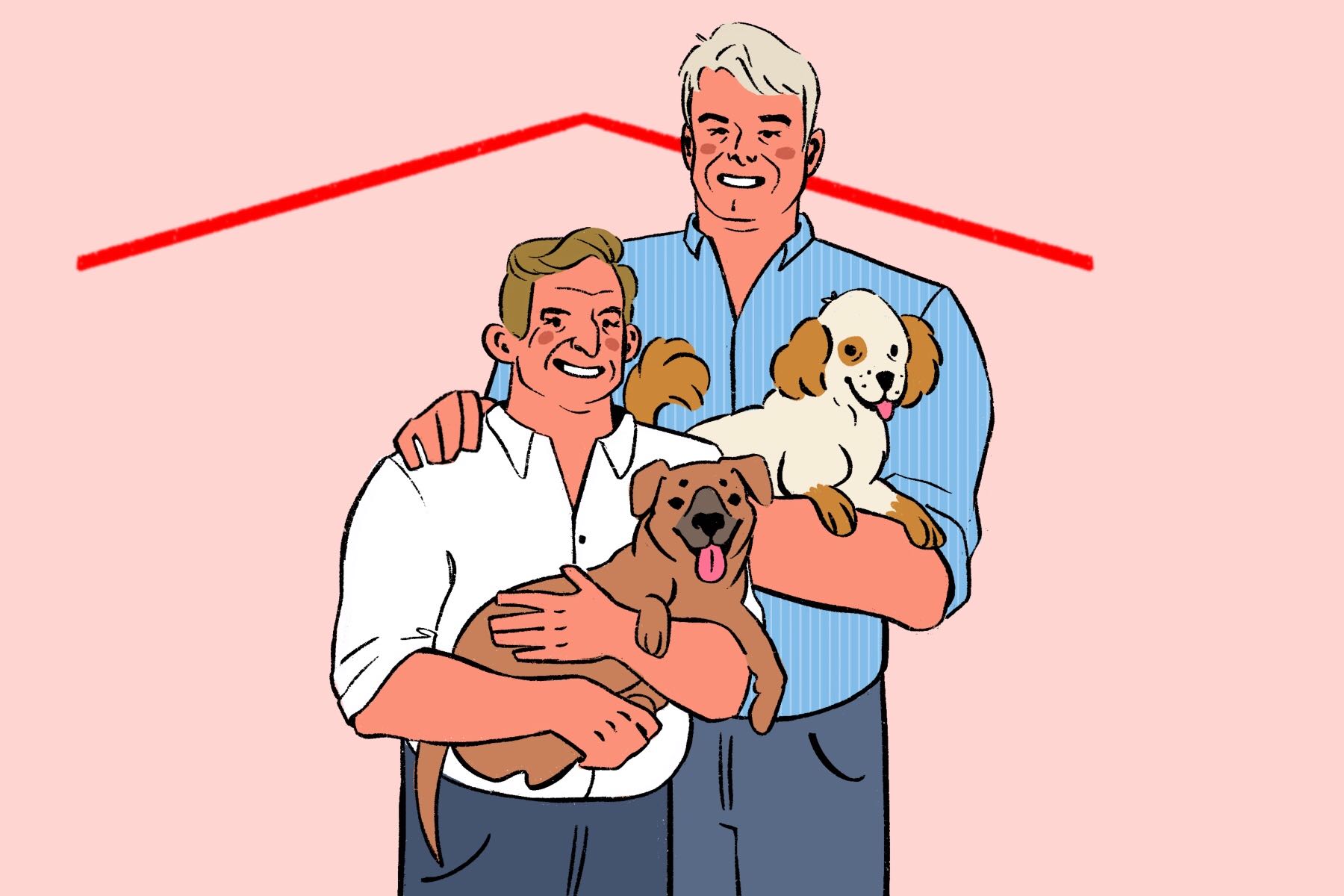Forty-four thousand square feet, 71 dogs and two men. Released in 2018 and filmed in the years prior, “Life in the Doghouse” documents the lives of Danny Robertshaw and Ron Danta, who have dedicated their entire home and property to rescuing dogs in Camden, South Carolina. Starting in 2005, in the aftermath of Hurricane Katrina, Danny and Ron decided that they were going to become a full-time rescue. They saved 600 dogs from Katrina and kept on rescuing, gradually converting each room of their home into a space for the dogs.
They explain in the film that their home used to be pretty — it was a space for people. They would host parties and Ron would cook in their kitchen. However, they gladly gave up the people space so the dogs they rescued would have a safe haven.
Their dining room is no longer a dining room; instead, it is full of crates. Their kitchen is now used as a space for socializing the dogs because of its foot traffic. Their living room is transformed into a lounging space for the dogs, especially Amelia, whose bed rests inside the non-functioning fireplace. The room is now the main living space of the bigger dogs, who have free reign over the furniture and a doggie door to let them outside.
The front bedroom is where they keep litters of puppies, although sometimes they also have to use their shower stall. Their screen-enclosed porch, which once housed a jacuzzi tub, is now a quarantine room for sick dogs. They also knocked a hole in their garage and built another room onto it to quarantine heartworm-positive dogs. Danny and Ron say that they “live in the dogs’ house.” Now, they are the guests.
Despite living in a doghouse, it doesn’t smell like one. This is because they, and their staff, spend most of the day cleaning. Their day begins at 6:30 and the first staff member arrives at 7:30. That’s when the cleaning begins. First, they collect and wash all of the food bowls in the dishwasher, and the water bowls are changed twice a day. They move all of the crates out of every room and vacuum and mop the floors. All bedding is taken out of the crates and washed — they do approximately 18 loads of laundry in a commercial washer and dryer. The puppy pens have to be scrubbed five times a day and Danny picks the yard four times a day. They use 10 gallons of laundry detergent, 56 rolls of paper towels, 60 pounds of dry food and 56 cans of dog food a week.
The amount of money needed to run the shelter is enormous. In addition to all of the supplies, they also have to pay their staff. Ron said that in the last year, they spent nearly a million dollars. However, the shelter is a 501(c)(3) nonprofit. They rely primarily on donations, which peak in December.
They do not charge an adoption fee. Instead, they ask for an affordable donation — whatever the amount the adopters can give. Danny and Ron used 40% of their retirement funds on rescuing dogs from Katrina. In “Life in the Doghouse,” Ron is shown taking out a loan for the rescue in his own name, because the rescue does not have enough equity. He wants a $100,000 loan but ends up with $50,000.
Danny and Ron earn their own money by training horses and do not take a salary from the rescue. They both have worked with horses the majority of their lives and actually met at a horse show. Danny started riding horses at the age of 10 and grew to be a champion horse-rider. He now judges shows across the country, in addition to training. Ron’s parents bought him a facility to train horses when he was younger but then he decided to move to South Carolina; his parents cut him off for seven years.
Danny and Ron had a working relationship for years and when they met, Ron was married to a woman. However, after eight years they got divorced, which proved devastating for Ron. Danny reached out to him during this time to offer support and their friendship eventually grew into something more. They’ve now been together for over 27 years, and they both say that if they did not have a mutual passion for animals, then Danny and Ron’s Rescue wouldn’t exist.
Most of the dogs that Danny and Ron rescue are dogs that aren’t likely to be adopted from shelters. They rescue injured dogs, senior and disabled dogs, black dogs, dogs that have been put on euthanasia lists, as well as dogs that come directly from puppy mills and kill shelters. On red code days — euthanasia days — they get nearly 100 emails from 20 shelters asking if they can take any dogs.
When visiting a kill shelter, they often aren’t allowed inside the facility. The shelter workers bring animals out to them and ask if they will take them. They take nearly all of them. Most of the dogs that were brought out to them in “Life in the Doghouse” were black dogs. Like black cats, black dogs are the least likely color to be adopted. Danny thinks this is because they are nondescript and don’t stand out.
While at the shelter, Ron made it very clear that the shelter was not to blame for the number of dogs being euthanized and that it was the community’s fault. When people don’t spay and neuter their pets, there are multiple litters of unwanted cats and dogs. These animals are then dropped off at shelters when homes can’t be found for them. Ron says, “There is one solution for overpopulation — spaying and neutering.” He thinks there should be a national law which requires pet owners to spay and neuter their pets unless they are a licensed breeder. However, when he spoke to a South Carolina official about this, he was told, “There was no way he was going to tell his hunting buddies they had to cut the balls off of their hunting dogs.”
However, overpopulation is a massive issue. In a drone shot of the kill shelter, while showing how they dispose of euthanized animals, the documentary listed off some statistics — 6.5 million animals enter U.S. shelters each year, 90% of which are not spayed or neutered. Of those 6.5 million animals, 2.5 million find homes. That leaves over four million animals to be euthanized.
Another contributor to overpopulation, and one that Danny and Ron are fighting against, are puppy mills. Puppy mills are breeders who care only about the dollar and not about the animal. They overbreed and inbreed, trying to produce the smallest, cutest animal possible. They keep the animals in wire rabbit cages where they can barely turn around. Some dogs will have 12 to 13 litters and their paws never even touch the ground.
They sell the puppies to pet stores and discard the animals that don’t sell to shelters and people like Danny and Ron. When handing the dogs off to Danny and Ron, they have to meet at a secondary location, because if anyone knew the location of the mill, it would be shut down. Most puppies in pet stores come from puppy mills. And buying a dog from a pet store does not mean you “rescued” it; you only contributed to the puppy mill. According to Ron, “If people would not buy from pet stores, puppy mills would go out of business.”
This is why Danny and Ron push for adoption. When their rescues become adoptable, they screen anyone who is interested and make sure the dog will be a good fit with the potential owners. They also bring dogs to all of their horse shows, driving the breeders who traditionally sell there out of business. The dogs who are considered “non-adoptable” — those who are too old, have behavior issues or disabilities — live out the rest of their lives with Danny and Ron as permanent residents. They are promised a safe haven and a peaceful exit from this world when their time comes.
Danny and Ron hope to get more young people involved with the rescue so the work can continue after they are gone. Ron also dreams of purchasing a bus, putting two or three full time vets on it and sending it around the country to give free spaying and neutering. However, this would only be possible if they won the lottery. Although they have discussed retirement, they both agree that they couldn’t do it; they would feel too guilty abandoning those in need. So, Danny and Ron’s Rescue will be up and running for a long time.
For more details, check out their website dannyronsrescue.org and the documentary’s website www.lifeinthedoghousemovie.com and watch “Life in the Doghouse,” on Netflix now.
















